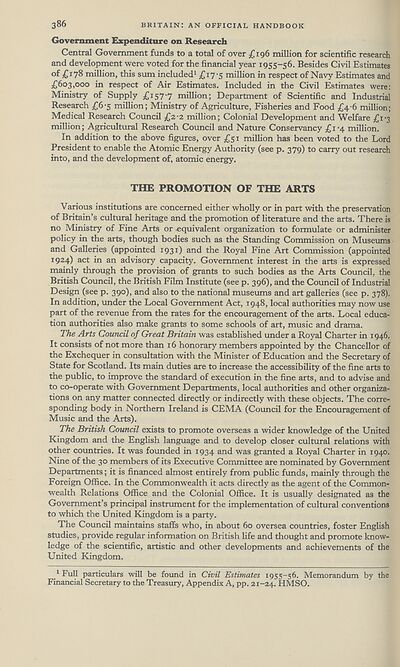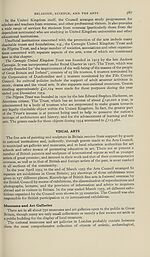Britain: An official handbook > 1956
(420)
Download files
Complete book:
Individual page:
Thumbnail gallery: Grid view | List view

BRITAIN: AN OFFICIAL HANDBOOK
386
Government Expenditure on Research
Central Government funds to a total of over £196 million for scientific research
and development were voted for the financial year 1955-56. Besides Civil Estimates
of £178 million, this sum included1 £17-5 million in respect of Navy Estimates and
£603,000 in respect of Air Estimates. Included in the Civil Estimates were:
Ministry of Supply £157-7 million; Department of Scientific and Industrial
Research £6-5 million; Ministry of Agriculture, Fisheries and Food £4-6 million;
Medical Research Council £2-2 million; Colonial Development and Welfare £1-3
million; Agricultural Research Council and Nature Conservancy £1-4 million.
In addition to the above figures, over £51 million has been voted to the Lord
President to enable the Atomic Energy Authority (see p. 379) to carry out research
into, and the development of, atomic energy.
THE PROMOTION OF THE ARTS
Various institutions are concerned either wholly or in part with the preservation
of Britain’s cultural heritage and the promotion of literature and the arts. There is
no Ministry of Fine Arts or equivalent organization to formulate or administer
policy in the arts, though bodies such as the Standing Commission on Museums
and Galleries (appointed 1931) and the Royal Fine Art Commission (appointed
1924) act in an advisory capacity. Government interest in the arts is expressed
mainly through the provision of grants to such bodies as the Arts Council, the
British Council, the British Film Institute (see p. 396), and the Council of Industrial
Design (see p. 390), and also to the national museums and art galleries (see p. 378).
In addition, under the Local Government Act, 1948, local authorities may now use
part of the revenue from the rates for the encouragement of the arts. Local educa¬
tion authorities also make grants to some schools of art, music and drama.
The Arts Council of Great Britain was established under a Royal Charter in 1946.
It consists of not more than 16 honorary members appointed by the Chancellor of
the Exchequer in consultation with the Minister of Education and the Secretary of
State for Scotland. Its main duties are to increase the accessibility of the fine arts to
the public, to improve the standard of execution in the fine arts, and to advise and
to co-operate with Government Departments, local authorities and other organiza¬
tions on any matter connected directly or indirectly with these objects. The corre¬
sponding body in Northern Ireland is CEMA (Council for the Encouragement of
Music and the Arts).
The British Council exists to promote overseas a wider knowledge of the United
Kingdom and the English language and to develop closer cultural relations with
other countries. It was founded in 1934 and was granted a Royal Charter in 1940.
Nine of the 30 members of its Executive Committee are nominated by Government
Departments; it is financed almost entirely from public funds, mainly through the
Foreign Office. In the Commonwealth it acts directly as the agent of the Common¬
wealth Relations Office and the Colonial Office. It is usually designated as the
Government’s principal instrument for the implementation of cultural conventions
to which the United Kingdom is a party.
The Council maintains staffs who, in about 60 oversea countries, foster English
studies, provide regular information on British life and thought and promote know¬
ledge of the scientific, artistic and other developments and achievements of the
United Kingdom.
1 Full particulars will be found in Civil Estimates 1955—56. Memorandum by the
Financial Secretary to the Treasury, Appendix A, pp. 21-24. HMSO.
386
Government Expenditure on Research
Central Government funds to a total of over £196 million for scientific research
and development were voted for the financial year 1955-56. Besides Civil Estimates
of £178 million, this sum included1 £17-5 million in respect of Navy Estimates and
£603,000 in respect of Air Estimates. Included in the Civil Estimates were:
Ministry of Supply £157-7 million; Department of Scientific and Industrial
Research £6-5 million; Ministry of Agriculture, Fisheries and Food £4-6 million;
Medical Research Council £2-2 million; Colonial Development and Welfare £1-3
million; Agricultural Research Council and Nature Conservancy £1-4 million.
In addition to the above figures, over £51 million has been voted to the Lord
President to enable the Atomic Energy Authority (see p. 379) to carry out research
into, and the development of, atomic energy.
THE PROMOTION OF THE ARTS
Various institutions are concerned either wholly or in part with the preservation
of Britain’s cultural heritage and the promotion of literature and the arts. There is
no Ministry of Fine Arts or equivalent organization to formulate or administer
policy in the arts, though bodies such as the Standing Commission on Museums
and Galleries (appointed 1931) and the Royal Fine Art Commission (appointed
1924) act in an advisory capacity. Government interest in the arts is expressed
mainly through the provision of grants to such bodies as the Arts Council, the
British Council, the British Film Institute (see p. 396), and the Council of Industrial
Design (see p. 390), and also to the national museums and art galleries (see p. 378).
In addition, under the Local Government Act, 1948, local authorities may now use
part of the revenue from the rates for the encouragement of the arts. Local educa¬
tion authorities also make grants to some schools of art, music and drama.
The Arts Council of Great Britain was established under a Royal Charter in 1946.
It consists of not more than 16 honorary members appointed by the Chancellor of
the Exchequer in consultation with the Minister of Education and the Secretary of
State for Scotland. Its main duties are to increase the accessibility of the fine arts to
the public, to improve the standard of execution in the fine arts, and to advise and
to co-operate with Government Departments, local authorities and other organiza¬
tions on any matter connected directly or indirectly with these objects. The corre¬
sponding body in Northern Ireland is CEMA (Council for the Encouragement of
Music and the Arts).
The British Council exists to promote overseas a wider knowledge of the United
Kingdom and the English language and to develop closer cultural relations with
other countries. It was founded in 1934 and was granted a Royal Charter in 1940.
Nine of the 30 members of its Executive Committee are nominated by Government
Departments; it is financed almost entirely from public funds, mainly through the
Foreign Office. In the Commonwealth it acts directly as the agent of the Common¬
wealth Relations Office and the Colonial Office. It is usually designated as the
Government’s principal instrument for the implementation of cultural conventions
to which the United Kingdom is a party.
The Council maintains staffs who, in about 60 oversea countries, foster English
studies, provide regular information on British life and thought and promote know¬
ledge of the scientific, artistic and other developments and achievements of the
United Kingdom.
1 Full particulars will be found in Civil Estimates 1955—56. Memorandum by the
Financial Secretary to the Treasury, Appendix A, pp. 21-24. HMSO.
Set display mode to:
![]() Universal Viewer |
Universal Viewer | ![]() Mirador |
Large image | Transcription
Mirador |
Large image | Transcription
The item on this page appears courtesy of Office for National Statistics and may be re-used under the Open Government Licence for Public Sector Information.
| Britain and UK handbooks > Britain: An official handbook > 1956 > (420) |
|---|
| Permanent URL | https://digital.nls.uk/205501727 |
|---|
| Attribution and copyright: |
|
|---|---|
| Description | 'Britain: An official handbook' was produced annually by the Central Office of Information from 1954-1998. There are 44 volumes available here to view. |
|---|---|
| Shelfmark | GII.11 |
| Description | Three titles produced by the British Government from 1954-2005 describing 'how Britain worked'. They are: 'Britain: An official handbook' (1954-1998), 'Britain: The official yearbook of the United Kingdom' (1999-2001), and 'UK: The official yearbook of the United Kingdom of Great Britain and Northern Ireland' (2002-2005). These 50 reports provide an overview of Britain's economic, social and cultural affairs, its environment, international relations, and the systems of government. They give an impartial summary of government policies and initiatives, and explain how public services are organised. |
|---|---|
| Additional NLS resources: |
|

